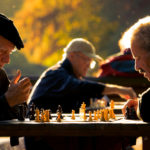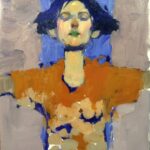
California artist’s paint mostly California scenes and so on. But that is just the surface layer in what makes us who we are. For me, family is first , and if all is well on the home front, all will be well in the studio. Working out of my house all those years as an illustrator kept me in close contact with my family, so I knew most of the time what my kids were up to and put out the daily fires that spring up when you are working out of your home. I love to cook so at the end of a hopefully good day in the studio, I’ll pour a drink and start prepping dinner. The process of switching from a brush to a spatula is relaxing and is great time to wind down. Food is such a great part of life that if we treat it only as fuel, we are missing out. Cooking, like art has core principals, and if you learn those principals, wonderful things can happen. My wife Debbie is a Kindergarten Teacher, so she comes home wiped out and in need to talk with an adult and I need to talk to anybody but the dogs. We have created a home we both really love and it is a place of sanctuary. Our neighbors and friends come over for Potluck dinners once a week. Living in Florida has allowed us to live outside year round and working for myself was a great way to work at another passion, my back yard. During a couple of good illustration years I starting putting patios, Tiki bar, fountains and an outdoor fireplace. Building the fireplace was an extension of my creative energy. 

As artist’s, we are sensitive to our environment and usually shows itself in our paintings. Some move to locals that inspire them and start creating the best art of their lives. For many of us moving is not feasible, but we can make our studio and home a place that inspires. My wife understands that her five year old students, who are starting school for the first time, need to feel safe and happy in order to learn. If our environment is one that inspires and makes us happy it will show in the art we produce. Collectors buy art that makes their lives better and are in essence buying a piece of who we are. I don’t want to sugar coat our careers as artists because it is very difficult, but I am reminded of a school talk I did years ago and at the end of my show a little boy asked me “so you get to stay home and color all day?” Yes, yes I do.
Oil Painting
Classical (Classic) Realism- Part 1
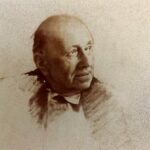
The 1960’s did not give a young student many options, so I took the logical, affordable one. For me, growing as an artist followed the path of trial and error with some influential and valuable guidance along the way. Mainly, however, I feel I am mostly self-taught. At one point in my career, I probably considered that a badge of honor, but not anymore. Now I consider it a shame and a powerful condemnation of the sad state of art education during my formative years.
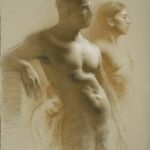
There are now art schools around the world, many in this country, that are intent on researching and restoring the teaching methods of old that produced the world’s greatest artists.
We really owe a great deal of gratitude to those who are dedicating themselves to teaching these traditional methods, for we’re already seeing the phenomenal results of such training among many of our younger artists.

In the interview that follows, my hope is that we gain a deeper understanding of what some are calling “Classical Realism”. What is it and what are it’s roots? What distinguishes classical training from other types of art instruction, and why is it important?
I think you will find this three-part interview very enlightening.
Michael John Angel

Juliette Aristides

David Hardy

Interview
“Classically trained” and “classical realism” are terms often bandied about by fine artists today. What exactly is meant by those terms?
 Aristides: Classical Realism was a term coined by Richard Lack. On the surface it looks like a contradiction of terms. Realism often refers to an unfiltered view of everyday life. Classism works within a tradition striving for an ideal between nature and design. I imagine the term Classical Realism reflects the striving of an artist to see and express the ideal in life. I love this definition of classism from an unlikely source, the Romantic artist, Eugene Delacroix: “I would readily apply the term “classical” to all well-ordered works which satisfy the mind, not only by an accurate, noble, or lively rendering of sentiments and objects, but also by their unity and logical arrangements. In short, by all those qualities which enhance the impression by creating a final simplicity.”
Aristides: Classical Realism was a term coined by Richard Lack. On the surface it looks like a contradiction of terms. Realism often refers to an unfiltered view of everyday life. Classism works within a tradition striving for an ideal between nature and design. I imagine the term Classical Realism reflects the striving of an artist to see and express the ideal in life. I love this definition of classism from an unlikely source, the Romantic artist, Eugene Delacroix: “I would readily apply the term “classical” to all well-ordered works which satisfy the mind, not only by an accurate, noble, or lively rendering of sentiments and objects, but also by their unity and logical arrangements. In short, by all those qualities which enhance the impression by creating a final simplicity.”
![]() Hardy: The terms “Classically trained” and “Classical Realism” vary in meaning in the art community because there is a wide range of understanding and cultural sophistication amongst some of those using these terms. I choose to name my atelier the Atelier School of Classical Realism for two reasons: (1) Atelier because I have adapted some of the teaching approaches and concepts popular in Paris in the 19th century. Atelier (French for ‘studio’) studies brought a limited (small) group of students together to learn from a respected master. (2) I firmly believe, with but a few later exceptions, that the major Baroque artists brought realism to a level rarely touched since. Because of this, I have made the effort to become very involved with Baroque technology. When I think of classical realism, I think of Old Master baroque artists, such as Rembrandt, Vermeer, Hals, Reubens, Van Dyke, Carravagio and Velasquez.
Hardy: The terms “Classically trained” and “Classical Realism” vary in meaning in the art community because there is a wide range of understanding and cultural sophistication amongst some of those using these terms. I choose to name my atelier the Atelier School of Classical Realism for two reasons: (1) Atelier because I have adapted some of the teaching approaches and concepts popular in Paris in the 19th century. Atelier (French for ‘studio’) studies brought a limited (small) group of students together to learn from a respected master. (2) I firmly believe, with but a few later exceptions, that the major Baroque artists brought realism to a level rarely touched since. Because of this, I have made the effort to become very involved with Baroque technology. When I think of classical realism, I think of Old Master baroque artists, such as Rembrandt, Vermeer, Hals, Reubens, Van Dyke, Carravagio and Velasquez.
 Angel: I hate to start off by being pedantic, but “Classical Realism” is actually a misnomer: the adjective Classical specifically refers to things from the Classical period in Greece (c.480 to 323 BC), and classical (lower-case C) refers more generally to things to do with Greece and ancient Rome. Classic Realism is better, or Traditional Realism. A classic shoe is just that, whereas a classical shoe is a sandal. The only classical painting that we have is vase painting. Realism is a difficult word, too, implying as it does things that we see in reality, i.e. everyday genre painting. This would exclude all symbolic allegory, including mythology, Christian or pagan. It also tends to exclude Conceptualism, but more about this later. I prefer Representational Painting (or Sculpture, of course), but it’s something of a mouthful. (Another much misused word is figurative. It actually means representational: a still life or a landscape are figurative, as are figural works such as nudes and portraits.) Sorry to go on, but you did ask!!
Angel: I hate to start off by being pedantic, but “Classical Realism” is actually a misnomer: the adjective Classical specifically refers to things from the Classical period in Greece (c.480 to 323 BC), and classical (lower-case C) refers more generally to things to do with Greece and ancient Rome. Classic Realism is better, or Traditional Realism. A classic shoe is just that, whereas a classical shoe is a sandal. The only classical painting that we have is vase painting. Realism is a difficult word, too, implying as it does things that we see in reality, i.e. everyday genre painting. This would exclude all symbolic allegory, including mythology, Christian or pagan. It also tends to exclude Conceptualism, but more about this later. I prefer Representational Painting (or Sculpture, of course), but it’s something of a mouthful. (Another much misused word is figurative. It actually means representational: a still life or a landscape are figurative, as are figural works such as nudes and portraits.) Sorry to go on, but you did ask!!
What characteristics are synonymous among all things classical?
 Aristides: It was said very well by the artist and author Kenyon Cox, in his book The Classic point of view (1911): “The Classic Spirit is the disinterested search for perfection; it is the love of clearness and reasonableness and self-control; it is, above all, the love of permanence and of continuity. It asks of a work of art, not that it shall be novel or effective, but that it shall be fine and noble. It seeks not merely to express individuality or emotion but to express disciplined emotion and individuality restrained by law. It strives for the essential rather than the accidental, the eternal rather than the momentary – loves impersonality more than personality, and feels more power in the orderly succession of the hours and the seasons than in the violence of earthquake or of storm.”
Aristides: It was said very well by the artist and author Kenyon Cox, in his book The Classic point of view (1911): “The Classic Spirit is the disinterested search for perfection; it is the love of clearness and reasonableness and self-control; it is, above all, the love of permanence and of continuity. It asks of a work of art, not that it shall be novel or effective, but that it shall be fine and noble. It seeks not merely to express individuality or emotion but to express disciplined emotion and individuality restrained by law. It strives for the essential rather than the accidental, the eternal rather than the momentary – loves impersonality more than personality, and feels more power in the orderly succession of the hours and the seasons than in the violence of earthquake or of storm.”
![]() Hardy: When I think of classical things, I think of search for truth, search for the ultimate in ideals, plus clarity and accessibility.
Hardy: When I think of classical things, I think of search for truth, search for the ultimate in ideals, plus clarity and accessibility.
Why do we credit and accept the Greeks as establishing the canons of beauty?
 Aristides: Greek art, in the Classical period, reached a remarkable balance between adherence to proportional cannons and naturalism. The Greeks moved away from static proportional systems, identifying and formalizing the attributes of beauty from nature. When looking at images from an art history timeline, you can see the Greeks so surpassed their predecessors in sophistication that the culture almost appears to spring up out of thin air.
Aristides: Greek art, in the Classical period, reached a remarkable balance between adherence to proportional cannons and naturalism. The Greeks moved away from static proportional systems, identifying and formalizing the attributes of beauty from nature. When looking at images from an art history timeline, you can see the Greeks so surpassed their predecessors in sophistication that the culture almost appears to spring up out of thin air.
 Hardy: Because they were there “firstest with the mostest”.
Hardy: Because they were there “firstest with the mostest”.
Why the fascination with ancient Greece and Rome?
 Aristides: In his book Civilization, Kenneth Clark wrote that “Western Europe had inherited an ideal invented in Greece in the 5th century B.C which was so satisfying to the mind and eye that it lasted practically unchanged for over six-hundred years”. During my travels this summer it is easy to see its powerful influence in America – in old city Philadelphia. It not only affected Europe, but when the New World was being shaped our founding fathers looked all the way back to Greco-Roman times, not only as a model for democracy, but also to their arts and architecture. It was the high point in philosophy, art, architecture, civic life, mathematics, etc and became the basis for Western Culture. The ancient Greeks were seeking after permanence and a perfect balance of reason, beauty and justice. They were trying to create a model civilization, not just copying what came before them…but innovating. Perhaps we are drawn to the best of those ideals.
Aristides: In his book Civilization, Kenneth Clark wrote that “Western Europe had inherited an ideal invented in Greece in the 5th century B.C which was so satisfying to the mind and eye that it lasted practically unchanged for over six-hundred years”. During my travels this summer it is easy to see its powerful influence in America – in old city Philadelphia. It not only affected Europe, but when the New World was being shaped our founding fathers looked all the way back to Greco-Roman times, not only as a model for democracy, but also to their arts and architecture. It was the high point in philosophy, art, architecture, civic life, mathematics, etc and became the basis for Western Culture. The ancient Greeks were seeking after permanence and a perfect balance of reason, beauty and justice. They were trying to create a model civilization, not just copying what came before them…but innovating. Perhaps we are drawn to the best of those ideals.
![]() Hardy: Because most of the ideals and structure of western society today were fermented and given birth in ancient Greece and Rome.
Hardy: Because most of the ideals and structure of western society today were fermented and given birth in ancient Greece and Rome.
Is the fascination with Greek and Roman antiquity concerned mainly with appearances or does it also extend to the philosophies of that time?
![]() Hardy: The almost exclusive survival of Greek art has been their statues. Greek statuary was an expression of their belief that all of their pantheon of gods existed as super perfect versions of humans…more handsome or beautiful, perfectly proportioned, more graceful.
Hardy: The almost exclusive survival of Greek art has been their statues. Greek statuary was an expression of their belief that all of their pantheon of gods existed as super perfect versions of humans…more handsome or beautiful, perfectly proportioned, more graceful.
 Aristides: Today, I don’t know that many artists are actually influenced by classical art, and architecture in the strict meaning of the word. Rather, I think there is a desire to understand artistic systems from the past so we can create the best art possible for the times in which we live. I think we are in such a disposable culture, the desire to make something that lasts, that attempts permanence, is compelling. We look back and are inspired to try a little harder.
Aristides: Today, I don’t know that many artists are actually influenced by classical art, and architecture in the strict meaning of the word. Rather, I think there is a desire to understand artistic systems from the past so we can create the best art possible for the times in which we live. I think we are in such a disposable culture, the desire to make something that lasts, that attempts permanence, is compelling. We look back and are inspired to try a little harder.
Mr. Angel has combined these last four questions into the following response:
 Angel: The sculpture of ancient Greece and Rome transcends everyday reality. We feel as though we are looking through the specific – the model, the subject – into the eternal, and this is why it haunts us. How do they accomplish this? All representational art should be a combination of the empirical and the conceptual. Modern ateliers teach the basic geometrical forms – at Angel’s, we teach that there are four pure ones: the cylinder, the egg, the block, and the pyramid, plus the various hybrids between these – and how to render these, illusionistically, on a two-dimensional surface. The ancients stressed these pure forms, modifying them empirically just enough to conjure the appearance of a human, but they leave us with the sense of the Eternal, the perennial flux. They combined this with a profound grasp of gesture, itself a conceptual thing, and of grace, which they created by the use of flow-through lines, rhyming forms and proportion. A great deal of our modern Realism deals only with the empirical, thinking that this is what the masters did; however, if I were to show you a reproduction of a Caravaggio (or a Ribera, or a van Dyck…) and tell you that this is a photo of some models posing, you wouldn’t believe me for a minute. Caravaggio, with or without mirror projections, has changed something; he has conceptualized (simplified and purified) the forms to make them more powerful and, ironically enough, more convincing.
Angel: The sculpture of ancient Greece and Rome transcends everyday reality. We feel as though we are looking through the specific – the model, the subject – into the eternal, and this is why it haunts us. How do they accomplish this? All representational art should be a combination of the empirical and the conceptual. Modern ateliers teach the basic geometrical forms – at Angel’s, we teach that there are four pure ones: the cylinder, the egg, the block, and the pyramid, plus the various hybrids between these – and how to render these, illusionistically, on a two-dimensional surface. The ancients stressed these pure forms, modifying them empirically just enough to conjure the appearance of a human, but they leave us with the sense of the Eternal, the perennial flux. They combined this with a profound grasp of gesture, itself a conceptual thing, and of grace, which they created by the use of flow-through lines, rhyming forms and proportion. A great deal of our modern Realism deals only with the empirical, thinking that this is what the masters did; however, if I were to show you a reproduction of a Caravaggio (or a Ribera, or a van Dyck…) and tell you that this is a photo of some models posing, you wouldn’t believe me for a minute. Caravaggio, with or without mirror projections, has changed something; he has conceptualized (simplified and purified) the forms to make them more powerful and, ironically enough, more convincing.
For more on these important artists:
A Week Painting at Scottsdale Art School with Milt Kobayashi
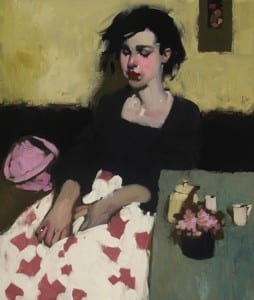 Last December, I was fortunate to be selected for a $500 scholarship from OPA to use toward attending a workshop of my choosing. Since I’ve long admired the rich, evocative figure paintings of Milt Kobayashi I elected to sign up for his recent class at the Scottsdale Artists School. The ocotillo and palo verde trees were blooming red-orange and yellow making April in Arizona a real joy.
Last December, I was fortunate to be selected for a $500 scholarship from OPA to use toward attending a workshop of my choosing. Since I’ve long admired the rich, evocative figure paintings of Milt Kobayashi I elected to sign up for his recent class at the Scottsdale Artists School. The ocotillo and palo verde trees were blooming red-orange and yellow making April in Arizona a real joy.
“Stay attuned to opportunities and be open to change” was the advice we received throughout the week. Kobayashi views his once a year class in Scottsdale as a valuable experimental time for himself as well as his students, painting new models, trying new compositions, hearing ideas from his class. He also enjoys the opportunity for creative freedom — no thinking about producing work for galleries or shows. Back home in New York he paints late into the night, the solitary work time often giving his paintings an introspective quality. Every year he says he takes something valuable back to his studio from his workshop experience; maybe something tangible, like a new color combination or maybe simply a creative spirit rejuvenated by the wide open southwest and the bonhomie of simpatico painters in the lively class. He certainly doesn’t take home the actual demos he does — the class participants were avid collectors and there was good natured rivalry on Friday when names were drawn for the chance to purchase the five new Kobayashis.
The emphasis for the week was on composition and he encouraged the 18 students to try new arrangements of objects, repeating several times that there are no rules about placement except try to avoid aligning edges. He enjoys pushing the figure to the far edge of a painting, sometimes even looking straight out to the side, an arrangement few artists use. He painted with various color schemes: dark blue (Egyptian blue by Doak) and brownish orange (Mars orange and Mars Yellow he likes for their rich opacity), orangey red-green-lavender, black with a host of grays, and the last day, medium blue and rusty red punctuated by a large area of black. He loves black and is not afraid to make the commitment to use it boldly.
He paints things how he thinks they should be, not exactly the way they look. Nothing is set in stone. He urges you to understand the form and why light is hitting it the way it is.
As he started to paint each morning, beginning with a tone of a warm gray, he seemed to let the design present itself to him. On occasion it was suggested by the shape and strokes of the initial tone, other times, it evolved from pencil lines over the tone as he played with placement of the objects he had in mind. On Tuesday, he decided to place the figure dead center with arms out stretched, making a cross composition. He further emphasized the centrality of the figure by placing a deliberate rectangle of blue right behind her face. He committed himself to his decision. When it came time to paint the mouth, he said with a laugh he was going to make it green, “just because I can.” He added a couple more touches of green so the color of the mouth would be repeated. The girl in the painting echoed his attitude of being attuned to possibilities and celebrating who she was.
In Kobayashi’s discussion of painting with cool and warm grays of similar values, he made a statement that distilled his decades of experience working in subtle tones: it won’t look muddy if you make the strokes crisp. When a painter starts to over blend it is easy for it to turn to mush.
Each afternoon for student painting time, there were three complex model set ups to choose from. These were orchestrated by artist Nancy Chaboun, who also participated in the workshop. Gorgeous fabrics, kimonos, fresh flowers, pillows, vases—if you couldn’t get inspired there, you couldn’t inspired anywhere.

Besides the great class at SAS, there was so much to take advantage of while in Scottsdale. I painted Monday evening in the open studio with a wonderful model, at no charge since I was enrolled in a workshop. Wednesday evening, one of the class members invited everyone to her lovely home for dinner where we also enjoyed her art collection which has an impressive number of Milt’s paintings. Thursday afternoon is Thirsty Thursday, put on by the Friends of SAS — great hors d’oeuvres and wine. Thursday evening is gallery walk for the Main Street galleries and the rest of my free time I spent plein air painting or photographing dramatic Arizona scenery. It was a fabulous art week.
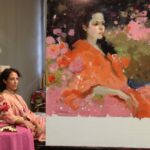 After some hit or miss work the first three days, finally on Thursday I felt I did a painting that incorporated some of Milt’s advice.
After some hit or miss work the first three days, finally on Thursday I felt I did a painting that incorporated some of Milt’s advice.In case I forget in the future to embolden my compositions, use lots of neutrals in the skin, or throw in a surprising color choice now and then, I only have to look back at Tuesday’s dead-center girl with the green lipstick to remind me–and that’s easy, because she hangs on my wall.
What can an artist do about it?
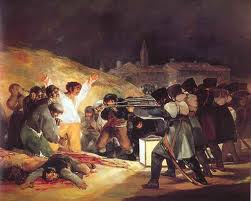
It was one of the most violent terrorist acts on America’s soil in recent history, at the world’s oldest annual marathon. Thousands experienced it locally and firsthand, as the event traditionally draws over 500,000 spectators. Millions viewed it on TV, replayed in shocking detail on every major national network.
Film showed runners who had just completed the race running back into the course to help the injured. Police and first responders rushed to the aid of the wounded with blankets, gurneys, and medical assistance. Viewers at televisions across the nation could only sit or stand transfixed as they tried to comprehend the carnage of the innocents who had suffered the shrapnel of a death-dealing blow. In living rooms everywhere, far from the smoke and violence, we were unable to think, breathe, or even lift a hand, transfixed by the horror of an ultimately cruel attack.
I have had the privilege to run the Boston Marathon three times. The highlight, for me, was The Hundredth, or Centennial Boston Marathon in 1996, that set the record for the world’s largest marathon at 38,708 entrants and 35,868 finishers. It’s properly called the “Boston Athletic Association Marathon,” and is begun and run in cities largely outside Boston—in fact, runners don’t even see Boston until five miles after Heartbreak Hill, at 24.5 miles. In fact, in the early days of the marathon, what was printed on the finishers’ medals was the name, “the American Marathon.”

But there was to be no victory that day, April 15th, for those runners on their way to the finish line at 2:49 p.m…. even for those who were turning that final corner onto Boylston Street to finally realize their dreams of completing “the Boston.” The bombings destroyed those dreams of the finish line in the same instant that they devastated the crowds gathered around that line. It was hopeless to go back, to wish it hadn’t happened. Only one question remained: “What can we do now; what should we do?”
That brings it all the way back, to each one of us. As artists, what can we do in the face of this disaster, and others, that threaten to destroy even the survivors?…that threatens to overwhelm all the good that exists in society, in any works of man and art, and which is powerful enough to reduce our creative morale to rubble?…so powerful that we might ultimately consider that the arts are nothing in the face of real evil, and that the artist and his/her artwork has “head in the clouds,” and is standing in front of tragedy without real weapons, or even an answer to man’s inhumanity to man.
Should we continue to stand, or run? Shouldn’t we feel defeated, then get angry, and seek revenge? Should we abandon our principles? If we do that, then we fall prey to the very behavior that we condemn in those who try to steal and destroy that which is good. In the wake of senseless acts like the Boston bombings, I feel all of those emotions—but that’s all they are. As an artist, I would rather attempt to do something positive, than to believe that there can be no response or action that is worthwhile, and helpful. So once again I have been considering the power of Art in light of this question: as an artist, what can I do to counteract this violence that exists in the world, this evil, this threat to all we hold to be true?
“Do not be overcome by evil, but overcome evil with good.” – Romans 12:21
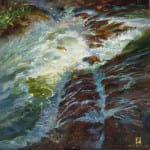
Artworks have the capacity to convey a positive message, to reveal the truth of the unseen, to describe beauty, to define the good that still exists, to communicate between cultures and without spoken language, and to heal. Perhaps that is why occupying armies frequently seek to destroy first the artworks of those they wish to vanquish—to immediately banish beauty, order, and hope in the good from the oppressed.
But each working artist that believes in the power of Art to convey the good is like a Florence Nightingale on the battlefield, among the tents where the wounded lie, going from one victim to the other and ministering to the spirits of those who would otherwise lose hope. Grace and strength will always win out over malice and wickedness. There is power in benevolence, and hope in the sight of the loveliness of a creative spirit. Art that expresses the truth in kindness and gratefulness will disarm the rage, and advance the welfare of all who see it.
As artists, we can do good, and strive to create great artworks. To create at the highest level is a victory over all who would strive to destroy.
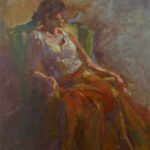
How Important is it to really Know your subject?
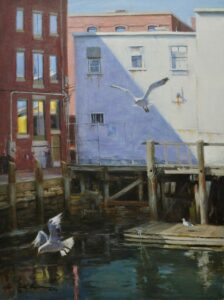
In my opinion, observation skills and a visual interest in how something looks with light on it is what is most important. A personal example might be that I love to paint boats and water, but I know very little about boats except which end is the bow and which is the stern. From observing, I am aware that the shape of a lobster boat is different that that of Shrimp boat, or an Oyster boat, etc. I have a passion for painting boats because I like the shapes and the way they look in water. That is only one example of many subjects that artist choose to paint that do not require expert knowledge to do reasonable representations of them.

By the same token, one can do a very reasonable rendition of the human form without ever taking an anatomy class…..of course anatomy study does not hurt, and I certainly would never discourage any one from studying the human anatomy. Any knowledge gained can be helpful…..particularly in checking one’s self if there is an issue, but it is not an absolute requirement. Artists have done a very good job over the years without studying anatomy, if their observation skills are strong. I believe the artist should be interpreting their observations and not simply copying them. Copying is for cameras. Another problem with relying on knowledge instead of observation is, if one is observing the subject, and something looks vague, fuzzy or not clear as in a shadow area….one should paint that image as they see it, and not use their intellectual knowledge of the subject and make it a clear statement. It will not look appropriate to that particular situation. Example….something dark in shadow value, if made to light and sharp will jump out of the shadow. Another foreseeable problem with using knowledge of subject rather than observation is that one could fall into a formula, and everything starts looking the same. If one is using anatomy knowledge for example. All figures should not be exactly alike.
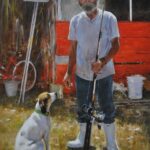
One could compile a never ending list of subjects that this might apply to. By no means am I implying that one should not learn all one can about the subject they choose to paint….if that is one’s interest. This is only my opinion on this subject, and does not necessarily reflect any universal opinion or idea on the subject. I do find this an interesting topic, and I do believe strong observation skills trump knowledge of a subject as it relates to painting.
Again thanks for listening to my Cajun ramblings.


